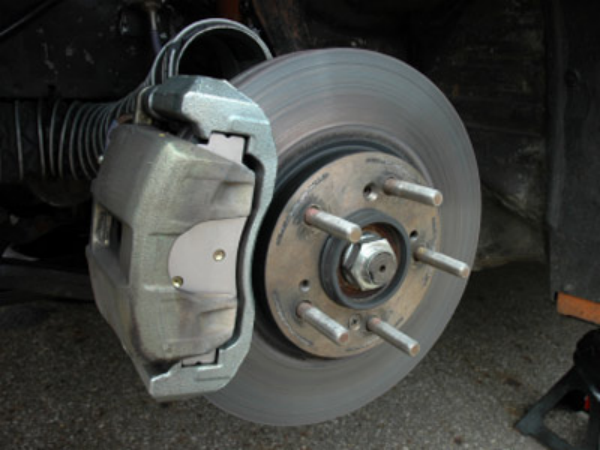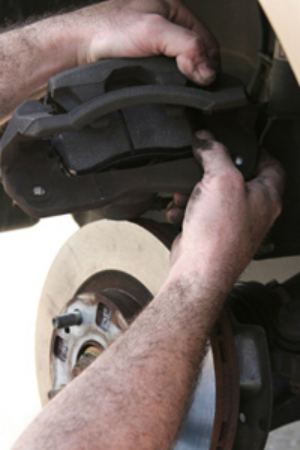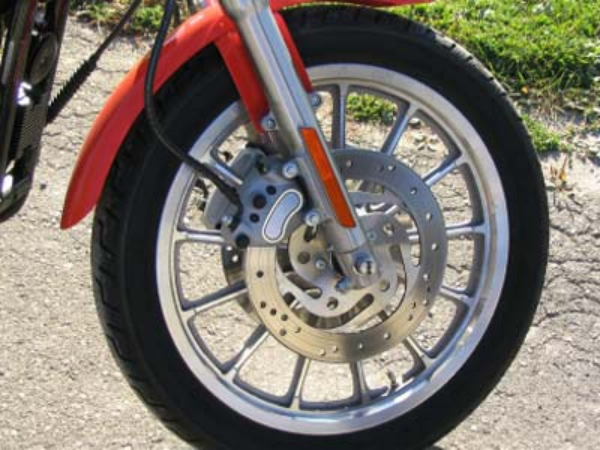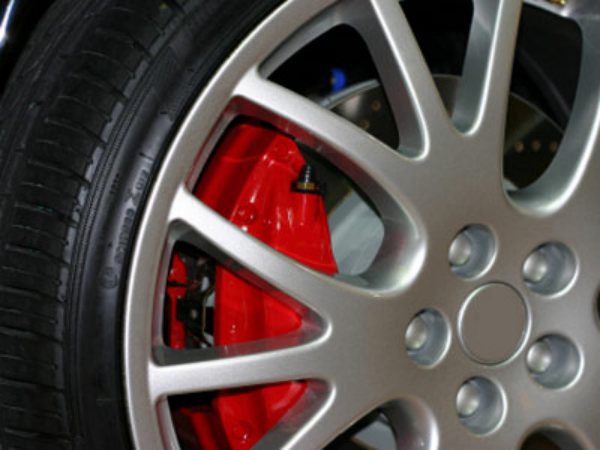Yuhuan Huayang Machinery Co., Ltd
Contact Sales at max

Brake caliper is very important to the braking ability of automobile, and can be said to be one of the most important automobile braking components. Anyway, most cars today have disc brakes, at least for the front wheels. However, now many cars and trucks also use disc brakes at the rear. In the disc brake system, the wheels of an automobile are fixed on a metal disc or rotor that rotates together with the wheels. The caliper's job is to slow down the speed of the wheel by friction with the rotor. The brake caliper is mounted on the rotor like a clamp. Inside each caliper is a pair of metal plates bonded with friction materials-these are called brake pads. The outer brake pad is on the outer side of the rotor (towards the outer side) and the inner brake pad is on the inner side (towards the vehicle). When you step on the brake, hydraulic pressure is generated from the brake fluid of the master cylinder to one or more pistons of the brake caliper, forcing the brake pads to face the rotor. Brake pads have high friction surfaces, which can slow down the rotor or even stop it completely. When the rotor slows down or stops, the wheels also slow down or stop because they are connected with each other. Old cars and trucks use drum brakes, which slow down the movement of wheels by friction between the rotating drum and the brake shoes installed in the drum. This friction causes heat and gas to accumulate in the drum, which often leads to the loss of braking ability, that is, braking attenuation. Because the brake pads in the disc brake system are outside the disc brake system instead of inside the drum, they are easier to ventilate and the heat will not accumulate quickly. For this reason, drum brakes have been largely replaced by disc brakes in modern cars; However, some less expensive cars still use drum brakes on the rear wheels, so that they don't need much braking power. There are two main types of calipers: floating (or sliding) calipers and fixed calipers. The floating caliper moves in and out relative to the rotor and has one or two pistons only on the inner side of the rotor. This piston pushes the entire caliper when the brake is applied, creating friction from both sides of the brake pad rotor. Fixed calipers, as the name implies, do not move, but there are pistons arranged on opposite sides of the rotor. Fixed calipers are usually preferred because of their performance, but they are more expensive than floating calipers. Some high-performance fixed calipers have two or more pairs of pistons arranged on each side of the rotor-some have as many as six pairs.
Brake tool
Brake pads won't last forever. Every time the brake pads in the disc brake system touch the rotating rotor, they wear a little. Gradually, these brake parts (brake pads) become thinner and thinner. To compensate for this, the piston is in the caliper from the hollow cylinder, and it resides in the caliper. When it does this, it pushes the worn brake pads further into the rotor. Eventually, the brake pads will need to be replaced with new, unworn pads. Unfortunately, the caliper piston (now almost completely lengthened) makes it difficult to remove and replace the pad. The piston needs to be pushed back into the caliper. This is a special brake pad tool. The work of the brake caliper tool is to retract the piston or return the piston to the caliper, so that the brake pad can be easily disassembled and replaced. The piston can't simply be pushed back into the caliper, because it is threaded, like a screw, and needs to be wound back. Although it is possible to use, say, a pair of pliers to do this, it is not recommended. You may damage pistons, calipers and your hands. The brake caliper tool is usually installed at one end of the piston, and there is a handle at the other end that allows it to rotate. When it rotates, the piston winds back to the caliper. If the sliding calipers start to jam, the floating calipers need to be repaired. This is usually caused by dust or rust. When this happens, even if the brake pedal is not depressed, the brake caliper cannot fully retract the brake pad from the rotor, and the friction continues. If enough heat is generated, it may lead to excessive wear of bearing bush, inefficient use of fuel and even deformation of rotor.
Motorcycle brake caliper
Motorcycles are smaller than cars, so they need less braking power. Nevertheless, in some respects, the ability of motorcycle to slow down or stop is more important than other vehicles. You might ask? Well, since the driver is basically unprotected, even a small fender bender can be fatal. It is essential to avoid accidents when riding motorcycles. But what kind of brake caliper does a motorcycle need? The answer is relatively simple and light. Unlike the larger calipers used in some cars and trucks, motorcycle brake calipers must be kept small so as not to overwhelm bicycles and hinder cyclists. Motorcycle brake calipers are usually made of lightweight materials (such as aluminum), which also has The advantages of rust prevention are increased. Some motorcycles are bigger and more powerful than others. Obviously, these bicycles need more braking force. Many smaller ones. Bicycles with low power still use drum brakes, but now most large bicycles have disc brakes-especially on the front wheels. In order to increase the braking force, calipers on stronger motorcycles usually have multiple pistons. Some have two or even four pistons, while others may have as many as twelve pistons in a single caliper. Due to the light weight, most motorcycles actually have more braking force than absolutely necessary-but as we mentioned earlier, it's not a bad idea when you ride a fast, unprotected vehicle. On motorcycles, front calipers are fixed to front forks-metal components hold front wheels and suspension in place and support handlebars. Until recently, calipers were fixed on the front fork with bolts extending at right angles to the rotor. In recent years, with the increasing popularity of radial disc brake (a technology used in racing cars), the caliper is fixed further away from the fork by bolts parallel to the rotor surface. These radially mounted calipers reduce the vibration generated in the fork by the conventionally mounted calipers. Because they tend to be more exposed than automobile calipers, and calipers may be the most noticeable of all motorcycle brake components. Therefore, the appearance of motorcycle calipers may be important to many riders. In fact, brake caliper paint can be obtained from auto shops and can be used to customize motorcycle brake caliper. Of course, the same paint can also be used on car calipers. However, experts suggest not to put chromium on calipers. Chrome plating may be very attractive, but it will cause heat retention in calipers, which will cause unnecessary brake attenuation.
Truck brake caliper
Undeniable: Trucks and SUVs are big-too big in some cases. As the size increases, so does the momentum. This means that trucks and SUVs need more braking force than cars. So where can they get the required braking force? Truck brake caliper. The braking force of the caliper depends on its clamping force-the force that the caliper can apply to the rotor surface. This mainly depends on the number of pistons and the surface area of brake pads (where they actually contact the rotor). Obviously, the brake caliper with larger clamping force can slow down or stop the vehicle more easily and quickly than the brake caliper with lower clamping force. Many trucks are equipped with basic floating calipers when they leave the factory. These calipers provide sufficient clamping force for vehicles when they are delivered to dealers. However, if larger tires and heavier accessories are customized for trucks, and a large number of goods are loaded on board, calipers installed in these factories may not be enough to provide the braking force required by trucks. Fortunately, there is a large after-sales market for calipers. In the manufacturer's opinion, trucks may have calipers, and their surface area between piston and rotor is about 5,000 square millimeters (7.8 square inches). The surface area of after-sales calipers can be more than doubled, thus providing the clamping force required by completely customized vehicles. There are more brake calipers in trucks than most brake parts, and it must bear a lot of heat. Heat is bad for the brake, because it will cause the brake to decay and shorten the braking distance. Good ventilation of calipers is essential for continuous and consistent braking performance. In addition, the larger surface of the brake rotor (or brake disc) can also help to spread the heat to a larger area. Trucks and off-road vehicles are not the only vehicles that need special braking equipment. However, the calipers of these heavy vehicles are really difficult to implement. Some people even say that truck brake caliper should be regarded as high-performance brake caliper.
High performance brake caliper
Disc brakes were originally developed for racing cars. Everyone knows that racing cars will drive at a high speed-but they also need to slow down quickly. In the early days of racing, most cars were equipped with drum brake system, and brake attenuation led to many track accidents. The disc brake system is well ventilated, thus reducing some pressure caused by racing and overheating. Accumulation can lead to-thereby reducing (but not eliminating) brake attenuation. With the passage of time, these powerful brakes gradually penetrated into the weaker vehicles. Now, they can even be found in most economical cars. Nevertheless, high-performance cars are still the main market for better and more powerful brakes, and changes in the design of basic caliper help these brakes provide excellent braking force. There are certain restrictions on how much the brake and its caliper can stop the vehicle. Although they may be able to stop the wheels, the tire's grip depends on the tire's grip, and the improved braking components will not help. However, there are several ways to improve the brake calipers. Some common functions of high-performance brake caliper include: Bigger pistons-The bigger the pistons are, and the greater their contact area with the brake pads, the greater their clamping force on the rotor. More pistons-The low-end floating caliper has a piston on the inside. The low-end fixed caliper has only one pair of pistons, which are located on both sides of the rotor disk. The high-performance caliper can have a plurality of pins or pairs of pins, which are installed on opposite sides of the rotor. Six-piston model is becoming more and more popular, and even twelve-piston model is not unheard of. The increase in the number of pistons is also used to increase the clamping force of calipers. Less heat retention-In a sense, your brake can be seen as a device that converts motion into heat. As the car slows down, all this kinetic energy must flow somewhere, and most of it will eventually be consumed in the form of heat. If you want to look at it from another angle, all the friction between the brake pad and the rotor will generate heat, just like matches generate heat. If too much heat is accumulated, the brake will begin to decay or fail. Therefore, the better the ventilation of brake calipers, the better their performance. Similarly, the larger the surface of the brake rotor, the more heat is dissipated. As the rotor surface of differential vernier caliper heats up, the clamping force of piston must be increased to prevent the brake from decaying. If the caliper has a plurality of pistons (or pairs of pistons), the surface of the brake piston will initially be heated by the piston pushing against the brake pad at the front edge of the caliper, so that the rotor surface will become hot when rotating back to the vicinity of the piston. Therefore, if the piston is closer to the rear edge of the caliper, its performance can be improved. Therefore, the differential caliper should use a smaller piston at the front and a larger piston at the back. All these technologies can improve the braking power provided by the caliper. For small cars that usually don't drive at high speed, this extra braking power is not really necessary. However, the faster and stronger the vehicle is, the more it will benefit from high-performance calipers.
Copyright©2018Yuhuan hua yang Machinery Co.,Ltd.|All Rights Reserved
Hello, please leave your name and email here before chat online so that we won't miss your message and contact you smoothly.